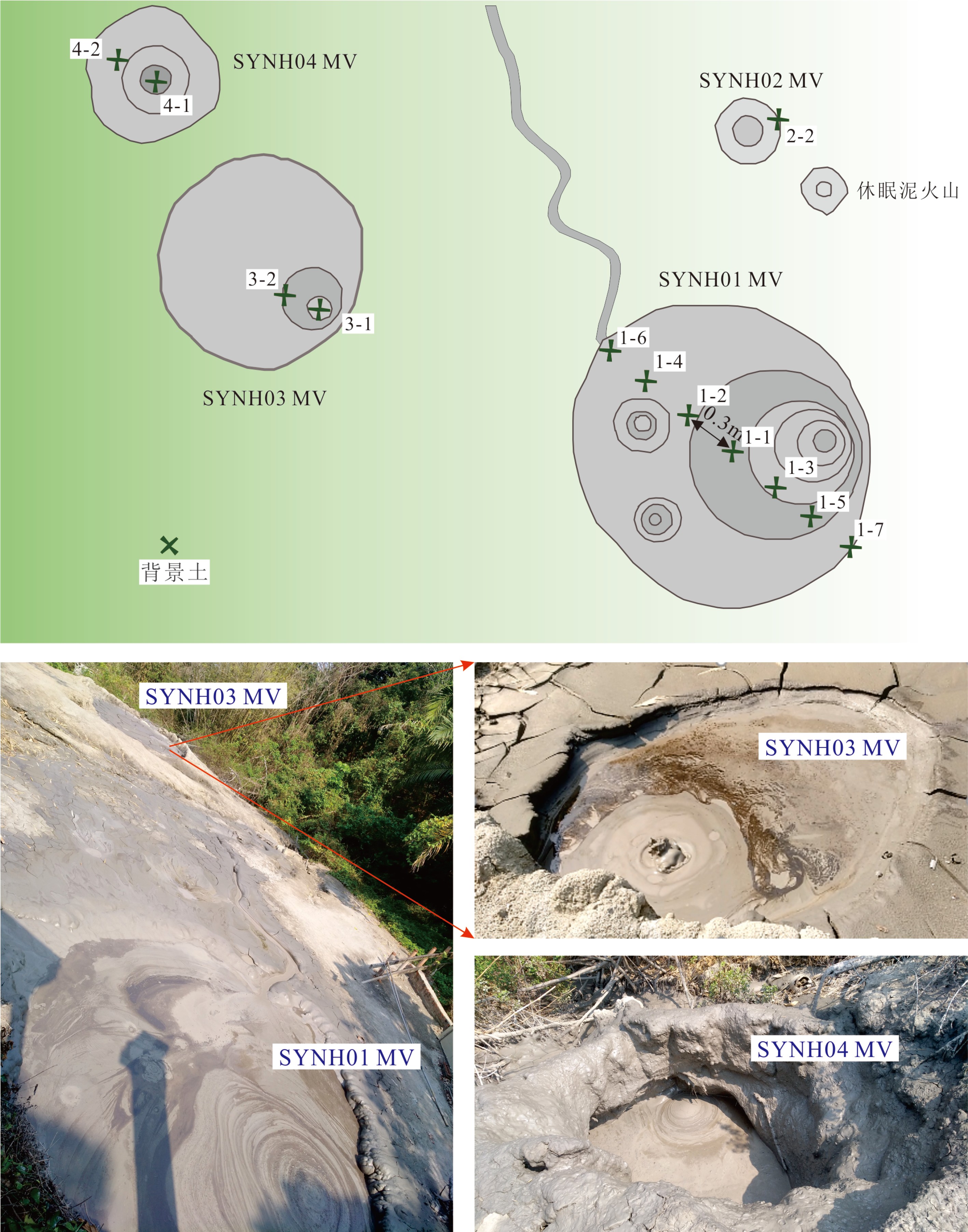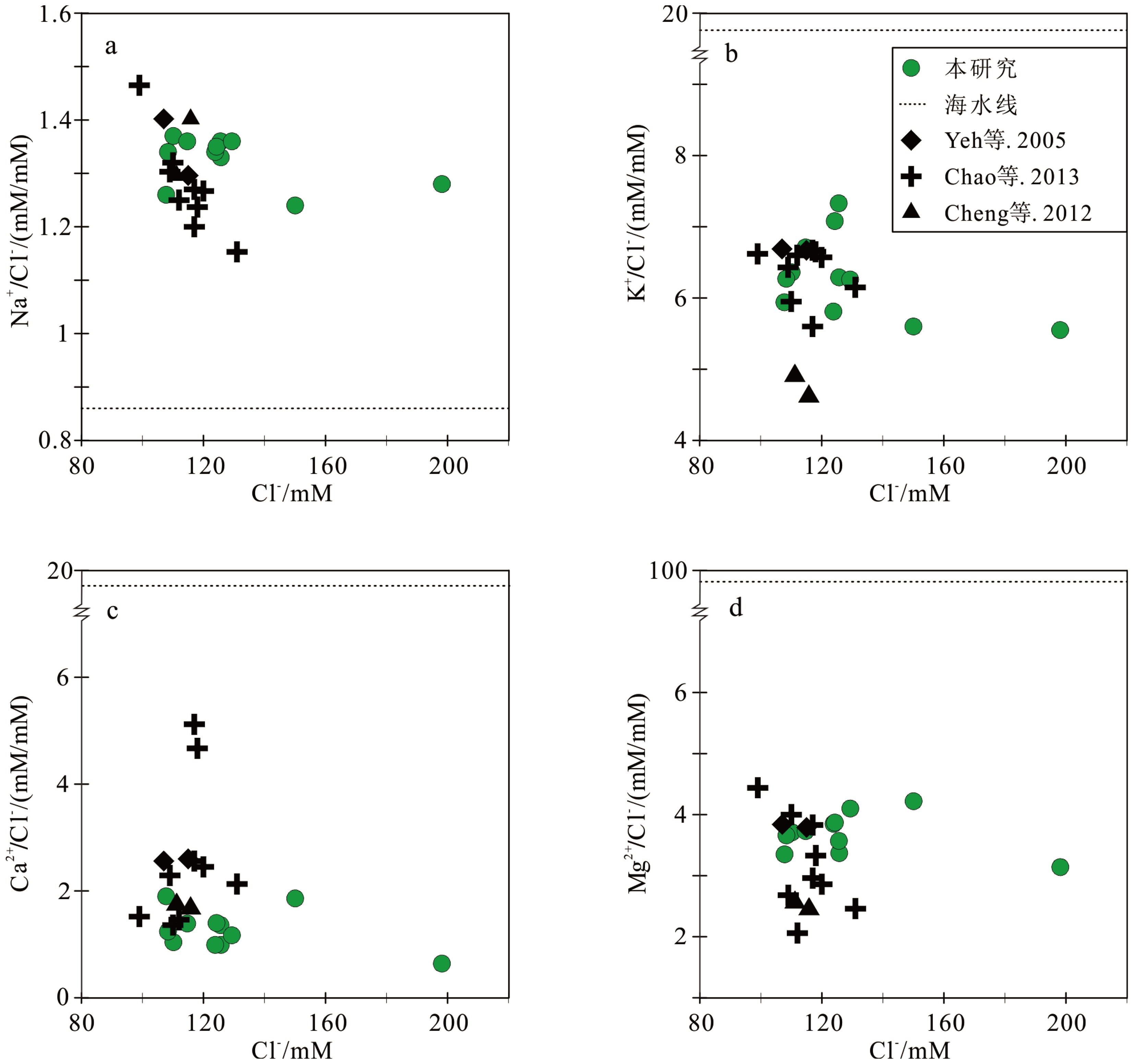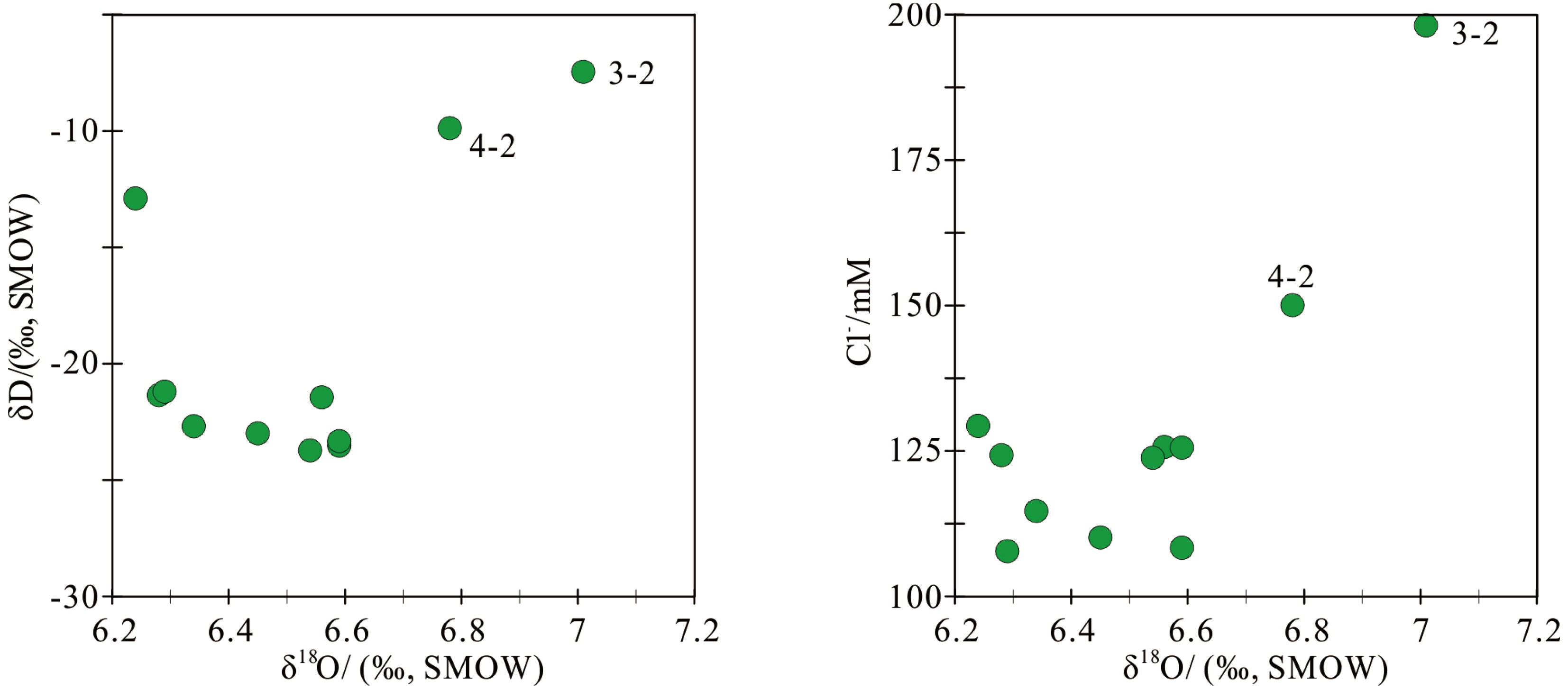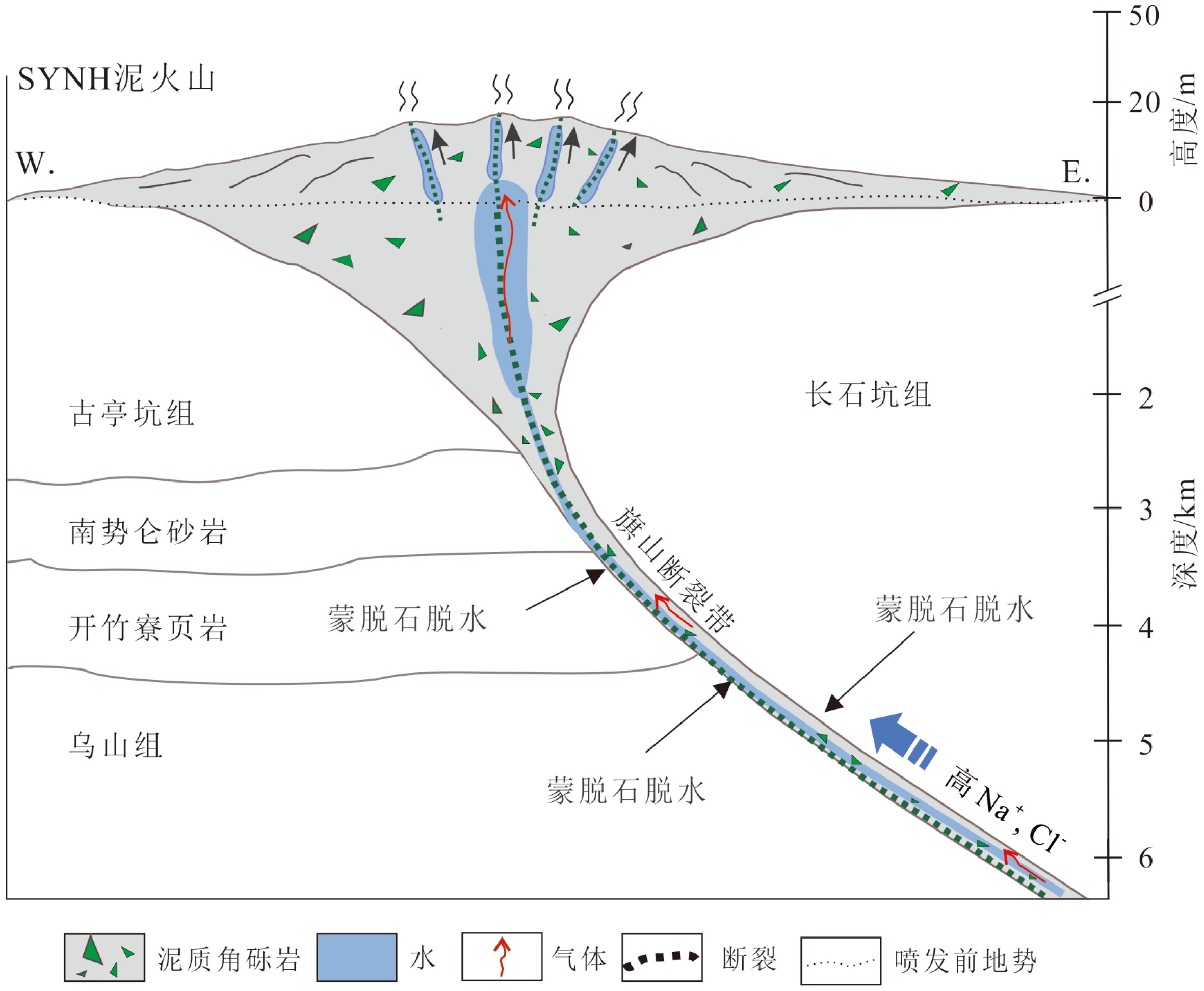Geochemical characteristics and source of pore fluids of the mud volcanoes in Shin-yan-ny-hu, Taiwan, China
-
摘要:
陆地泥火山流体来源及其演化过程的研究,对于理解板块俯冲边界增生楔中流体特性及迁移途径有重要作用,对于油气等资源勘探具有指示意义。通过分析台湾西南部新养女湖(SYNH)泥火山喷出流体的离子组分、氢氧同位素组分以及泥质沉积物的矿物组分,探索泥火山喷出流体源区的化学特征、流体的来源及源区温度和深度条件;搭建组分运移、演化的概念模型。调查发现SYNH泥火山喷出泥质沉积物的矿物以石英、长石、伊利石、绿泥石为主,含少量方解石和白云石。流体中Na+、Cl−占主导,且Na+和Cl−呈显著正相关,表明泥火山流体起源于海洋沉积孔隙水。泥浆池中流体的Cl−浓度约为海水的1/5;氧同位素δ18O为6.24‰~6.59‰,明显富集18O;氢同位素δD的范围为−23.72‰~−12.9‰,显示贫化的特征。Cl−浓度和氢氧同位素特征指示蒙脱石脱水稀释流体组分、改变流体的化学特征。此外,氢氧同位素分布偏移大气降水线,表明大气降水对泥火山流体的影响较小。流体中富集Na+,严重贫化K+,可能与蒙脱石的伊利石化作用有关。根据Na/K、K/Na地温计和氢氧同位素数据推算深部流体的温度范围为79~181 ℃。结合地温梯度,推测SYNH泥火山喷出流体起源的深度为2.6~6.0 km,对应中新世长石坑组及乌山组的页岩-砂岩和上新世的开竹寮页岩。基于研究区构造背景、矿物组成及流体地球化学特征搭建SYNH泥火山深部流体喷出过程的简化模型,即原始海水组分被保留在孔隙中,塑性页岩的圈闭作用使得孔隙流体排出不均衡,随着上覆岩层的压实作用及横向构造挤压,孔隙内部流体压力急剧升高,当压力大于上覆岩层压力或存在高渗通道时,流体携带沉积物喷出地表。
Abstract:The sources and geochemical evolution of pore fluids of terrestrial mud volcanoes are critical to the understanding of the features and migrating paths of the fluids in subduction accretionary prisms. They are also important to oil and gas exploration. In order to get an answer to the problems mentioned above, we analyzed the ionic composition, and the hydrogen and oxygen isotopes of mud volcanic fluids as well as the mineral composition of the sediments of mud volcanos taking the Shin-yan-ny-hu (SYNH) mud volcano, Taiwan, China as a case. The analysis results suggest that the erupted minerals by the mud volcano are dominated by quartz, feldspar, illite and chlorite, with a small amount of calcite and dolomite, while in the fluids, Na+ and Cl− dominate and there is a significant positive correlation between Na+ and Cl−. Such a correlation suggests that the fluids are derived mainly from pore water of marine sediments. The Cl− concentration of the fluid is about one-fifth of the seawater, characterized by enriched oxygen isotopes (δ18O: 6.24‰~6.59‰) and depleted hydrogen isotopes (δD: −23.72‰~−12.9‰), indicating the dehydration of smectite. The hydrogen and oxygen isotopes are obviously deviated from meteoric precipitation, the results support the conclusion that the influences of meteoric precipitation on this area are limited. Comparing to seawater, the fluids are rich in Na+ and severely depleted in K+, owing to the increase in smectite by illite/smectite interaction. The geochemical signatures of the pore fluids further suggest that the fluids sourced from the deep with temperatures ranging between 79 ℃−181 ℃ responding to a source region 2.6 km to 6.0 km in depth, where, as we know, occur the Kai-tzu-liao shales of Pliocene, and the interbedded shale and sandstone sequence of Miocene Chang-chi-keng and Wu-shan Formations. Based on the tectonic background, mineral composition and fluid sources of the SYNH mud volcanos, we established a theoretical model in this paper: The pore fluids of marine sediments trapped by the plastic shales caused the uneven ejection of pore water. With the compaction by the overlying sediments and lateral extrusions, the pressures of pore fluids increased sharply. Finally, the fluids carrying sediments erupted out, when the pressures are greater than that of overlying rocks if there are high-permeability channels.
-
Key words:
- mud volcano /
- pore fluid /
- smectite dehydration /
- geothermometer /
- fluid source
-

-
图 1 台湾南部地区区域构造图[11]
Figure 1.
图 8 SYNH泥火山流体运移及反应简化模型[19]
Figure 8.
表 1 SYNH泥火山4个喷口流体的地球化学组成及含量
Table 1. Geochemical compositions of discharged fluids from SYNH mud volcanoes.
样品编号 Cl−/
mMNH4+/
mMNa+/
mMK+/
mMMg2+/
mMCa2+/
mMMn2+/
μMCr/
μMBa2+/
μMSr2+/
μMU/
μMTi/
μMMo/
μMδ18OSMOW/
‰δDSMOW/
‰K/Na地
温计/℃Na/K地
温计/℃SYNH01-6 110.1 0.32 150.5 0.70 0.409 0.114 0.23 0.0029 2.27 17.35 0.050 0.28 1.82 6.45 −22.99 ND ND SYNH01-4 125.7 0.40 167.1 0.79 0.424 0.125 0.29 0.0038 2.72 20.53 0.053 0.26 2.02 6.56 −21.44 88.1 98 SYNH01-2 114.7 0.33 155.9 0.77 0.428 0.160 0.46 0.0015 1.80 19.43 0.055 0.33 2.15 6.34 −22.68 90.4 98.9 SYNH01-1 123.8 0.38 165.6 0.72 0.477 0.123 0.31 0.0038 2.80 19.40 0.050 0.26 1.74 6.54 −23.72 85.2 96.9 SYNH01-3 125.6 0.42 170.6 0.92 0.449 0.171 0.43 0.0019 2.30 24.05 0.068 0.38 3.16 6.59 −23.52 93.9 100.3 SYNH01-5 108.4 0.40 144.86 0.68 0.397 0.134 0.35 0.0023 2.61 19.69 0.045 0.32 1.60 6.59 −23.33 88.1 98 SYNH01-7 124.3 0.47 167.6 0.88 0.481 0.174 0.44 0.0027 2.53 23.53 0.057 0.38 2.42 6.28 −21.35 ND ND SYNH02-2 216.1 0.32 289.1 1.34 1.230 0.389 1.53 0.0142 0.85 42.02 0.081 1.00 4.16 5.58 0.4 ND ND SYNH03-1 129.3 0.33 176.5 0.81 0.531 0.151 0.37 0.0012 1.74 19.11 0.067 0.38 2.15 6.24 −12.90 87.2 97.6 SYNH03-2 198.1 0.49 254.5 1.10 0.621 0.127 0.13 0.0040 1.74 29.72 0.082 0.35 3.58 7.01 −7.45 ND ND SYNH04-1 107.8 0.45 135.9 0.64 0.361 0.205 0.27 0.0035 2.64 18.45 0.057 0.47 2.34 6.29 −21.20 88 97.9 SYNH04-2 150.1 0.30 186.6 0.84 0.634 0.280 0.47 0.0037 1.59 26.90 0.078 0.63 3.74 6.78 −9.88 ND ND 注:ND 表示未计算温度值。 表 2 SYNH泥火山喷出泥的矿物组分及含量
Table 2. Mineralogical compositions of the erupted mud by SYNH mud volcanoes.
% 样品编号 石英 长石 伊利石 绿泥石 方解石 白云石 SYNH01-6 40.9 15.2 19.0 21.7 2.2 0.9 SYNH01-4 39.7 14.8 20.6 21.5 1.4 1.9 SYNH01-2 38.6 16.0 19.5 22.3 0.5 3.0 SYNH01-1 42.5 16.8 16.7 21.6 1.5 0.9 SYNH01-3 47.6 14.5 15.1 18.4 3.1 1.4 SYNH01-5 39.7 16.2 17.6 19.9 4.2 2.4 SYNH01-7 45.4 18.5 12.4 16.4 5.4 1.9 SYNH02-2 42.5 15.2 17.5 19.3 3.4 2.1 SYNH03-1 44.0 14.9 17.7 20.0 1.4 2.0 SYNH03-2 47.2 19.8 12.9 15.0 1.1 3.9 SYNH04-1 43.0 16.3 17.6 19.7 1.2 2.2 SYNH04-2 37.5 12.7 20.7 22.6 2.0 4.4 背景土 49.8 16.7 12.5 17.5 1.2 2.2 -
[1] Milkov A V. Worldwide distribution of submarine mud volcanoes and associated gas hydrates [J]. Marine Geology, 2000, 167(1-2): 29-42. doi: 10.1016/S0025-3227(00)00022-0
[2] Dimitrov L I. Mud volcanoes-the most important pathway for degassing deeply buried sediments [J]. Earth-Science Reviews, 2002, 59(1-4): 49-76. doi: 10.1016/S0012-8252(02)00069-7
[3] Kopf A J. Significance of mud volcanism [J]. Reviews of Geophysics, 2002, 40(2): 1005. doi: 10.1029/2000RG000093
[4] Kholodov V N. Mud volcanoes, their distribution regularities and genesis: communication 1. mud volcanic provinces and morphology of mud volcanoes [J]. Lithology and Mineral Resources, 2002, 37(3): 197-209. doi: 10.1023/A:1015425612749
[5] Mazzini A, Etiope G. Mud volcanism: an updated review [J]. Earth-Science Reviews, 2017, 168: 81-112. doi: 10.1016/j.earscirev.2017.03.001
[6] Milkov A V, Sassen R, Apanasovich T V, et al. Global gas flux from mud volcanoes: a significant source of fossil methane in the atmosphere and the ocean [J]. Geophysical Research Letters, 2003, 30(2): 1037.
[7] Etiope G, Milkov A V. A new estimate of global methane flux from onshore and shallow submarine mud volcanoes to the atmosphere [J]. Environmental Geology, 2004, 46(8): 997-1002. doi: 10.1007/s00254-004-1085-1
[8] Chao H C, You C F, Sun C H. Gases in Taiwan mud volcanoes: chemical composition, methane carbon isotopes, and gas fluxes [J]. Applied Geochemistry, 2010, 25(3): 428-436. doi: 10.1016/j.apgeochem.2009.12.009
[9] Dia A N, Castrec-Rouelle M, Boulègue J, et al. Trinidad mud volcanoes: where do the expelled fluids come from? [J]. Geochimica et Cosmochimica Acta, 1999, 63(7-8): 1023-1038. doi: 10.1016/S0016-7037(98)00309-3
[10] Martin J B, Kastner M, Henry P, et al. Chemical and isotopic evidence for sources of fluids in a mud volcano field seaward of the Barbados accretionary wedge [J]. Journal of Geophysical Research: Solid Earth, 1996, 101(B9): 20325-20345. doi: 10.1029/96JB00140
[11] Chao H C, You C F, Liu H C, et al. The origin and migration of mud volcano fluids in Taiwan: evidence from hydrogen, oxygen, and strontium isotopic compositions [J]. Geochimica et Cosmochimica Acta, 2013, 114: 29-51. doi: 10.1016/j.gca.2013.03.035
[12] Babadi M F, Mehrabi B, Tassi F, et al. Origin of fluids discharged from mud volcanoes in SE Iran [J]. Marine and Petroleum Geology, 2019, 106: 190-205. doi: 10.1016/j.marpetgeo.2019.05.005
[13] Planke S, Svensen H, Hovland M, et al. Mud and fluid migration in active mud volcanoes in Azerbaijan [J]. Geo-Marine Letters, 2003, 23(3-4): 258-268. doi: 10.1007/s00367-003-0152-z
[14] Teng L S. Geotectonic evolution of late cenozoic arc-continent collision in Taiwan [J]. Tectonophysics, 1990, 183(1-4): 57-76. doi: 10.1016/0040-1951(90)90188-E
[15] Shih T T. A survey of the active mud volcanoes in Taiwan and a study of their types and the character of the mud [J]. Petrol Geol Taiwan, 1967, 5: 259-310.
[16] Sung Q C, Chang H C, Liu H C, et al. Mud volcanoes along the Chishan fault in Southwestern Taiwan: a release bend model [J]. Geomorphology, 2010, 118(1-2): 188-198. doi: 10.1016/j.geomorph.2009.12.018
[17] Chang P Y, Chang S K, Liu H C, et al. Using integrated 2D and 3D resistivity imaging methods for illustrating the mud-fluid conduits of the Wushanting mud volcanoes in Southwestern Taiwan [J]. Terrestrial Atmospheric and Oceanic Sciences, 2011, 22(1): 1-14. doi: 10.3319/TAO.2010.06.28.01(TT)
[18] Yang T F, Yeh G H, Fu C C, et al. Composition and exhalation flux of gases from mud volcanoes in Taiwan [J]. Environmental Geology, 2004, 46(8): 1003-1011. doi: 10.1007/s00254-004-1086-0
[19] Sun C H, Chang S C, Kuo C L, et al. Origins of Taiwan's mud volcanoes: evidence from geochemistry [J]. Journal of Asian Earth Sciences, 2010, 37(2): 105-116. doi: 10.1016/j.jseaes.2009.02.007
[20] Chang Y H, Cheng T W, Lai W J, et al. Microbial methane cycling in a terrestrial mud volcano in eastern Taiwan [J]. Environmental Microbiology, 2012, 14(4): 895-908. doi: 10.1111/j.1462-2920.2011.02658.x
[21] Cheng T W, Chang Y H, Tang S L, et al. Metabolic stratification driven by surface and subsurface interactions in a terrestrial mud volcano [J]. The ISME Journal, 2012, 6(12): 2280-2290. doi: 10.1038/ismej.2012.61
[22] Gieskes J M, You C F, Lee T, et al. Hydro-geochemistry of mud volcanoes in Taiwan [J]. Acta Geologica Taiwanica, 1992, 30: 79-88.
[23] Yeh G H, Yang T F, Chen J C, et al. Fluid geochemistry of mud volcanoes in Taiwan[C]//Martinelli G, Panahi B. Mud Volcanoes, Geodynamics and Seismicity. Netherlands: Springer, 2005: 227-237.
[24] Liu C C, Jean J S, Nath B, et al. Geochemical characteristics of the fluids and muds from two southern Taiwan mud volcanoes: implications for water-sediment interaction and groundwater arsenic enrichment [J]. Applied Geochemistry, 2009, 24(9): 1793-1802. doi: 10.1016/j.apgeochem.2009.06.002
[25] You C F, Gieskes J M, Lee T, et al. Geochemistry of mud volcano fluids in the Taiwan accretionary prism [J]. Applied Geochemistry, 2004, 19(5): 695-707. doi: 10.1016/j.apgeochem.2003.10.004
[26] Suppe J. A retrodeformable cross section of northern Taiwan [J]. Proceedings-Geological Society of China, 1980, 23: 46-55.
[27] Lin A T, Watts A B, Hesselbo S P. Cenozoic stratigraphy and subsidence history of the South China Sea margin in the Taiwan region [J]. Basin Research, 2003, 15(4): 453-478. doi: 10.1046/j.1365-2117.2003.00215.x
[28] Wang S, Shu M, Yang C. Morphological study of mud volcanoes on land in Taiwan [J]. Nat. Taiwan Museum, 1988, 31: 31-49.
[29] Chao H C, You C F, Wang B S, et al. Boron isotopic composition of mud volcano fluids: implications for fluid migration in shallow subduction zones [J]. Earth and Planetary Science Letters, 2011, 305(1-2): 32-44. doi: 10.1016/j.jpgl.2011.02.033
[30] Mazzini A, Svensen H, Planke S, et al. When mud volcanoes sleep: insight from seep geochemistry at the Dashgil mud volcano, Azerbaijan [J]. Marine and Petroleum Geology, 2009, 26(9): 1704-1715. doi: 10.1016/j.marpetgeo.2008.11.003
[31] Dählmann A, De Lange G J. Fluid-sediment interactions at Eastern Mediterranean mud volcanoes: a stable isotope study from ODP Leg 160 [J]. Earth and Planetary Science Letters, 2003, 212(3-4): 377-391. doi: 10.1016/S0012-821X(03)00227-9
[32] Reitz A, Pape T, Haeckel M, et al. Sources of fluids and gases expelled at cold seeps offshore Georgia, eastern Black Sea [J]. Geochimica et Cosmochimica Acta, 2011, 75(11): 3250-3268. doi: 10.1016/j.gca.2011.03.018
[33] Wu J N. New data processing algorithm for marine heat flow and thermal modeling for Tsan-Yao mud volcano offshore SW Taiwan[D]. Taipei: Institute of Oceanography College of Science, National Taiwan University, 2016.
[34] Coplen T B, Hanshaw B B. Ultrafiltration by a compacted clay membrane-I. oxygen and hydrogen isotopic fractionation [J]. Geochimica et Cosmochimica Acta, 1973, 37(10): 2295-2310. doi: 10.1016/0016-7037(73)90105-1
[35] Rolfe P F, Aylmore L A G. Water and salt flow through compacted clays: I. Permeability of compacted illite and montmorillonite [J]. Soil Science Society of America Journal, 1977, 41(3): 489-495. doi: 10.2136/sssaj1977.03615995004100030011x
[36] Kastner M, Elderfield H, Martin J B. Fluids in convergent margins: what do we know about their composition, origin, role in diagenesis and importance for oceanic chemical fluxes? [J]. Philosophical Transactions of the Royal Society of London. Series A: Mathematical Physical and Engineering Sciences, 1991, 335(1638): 243-259. doi: 10.1098/rsta.1991.0045
[37] Savin S M, Epstein S. The oyxgen and hydrogen isotope geochemistry of ocean sediments and shales [J]. Geochimica et Cosmochimica Acta, 1970, 34(1): 43-63. doi: 10.1016/0016-7037(70)90150-X
[38] Capuano R M. The temperature dependence of hydrogen isotope fractionation between clay minerals and water: evidence from a geopressured system [J]. Geochimica et Cosmochimica Acta, 1992, 56(6): 2547-2554. doi: 10.1016/0016-7037(92)90208-Z
[39] Shanks III W C, Bohlke J K, Seal II R R. Stable isotopes in mid-ocean ridge hydrothermal systems: Interactions between fluids, minerals, and organisms[M]//Humphris S E, Zierenberg R A, Mullineaux L S, et al. in Seafloor hydrothermal systems: Physical, Chemical, Biological, and Geological Interactions. Geophysical Monograph Series, 1995: 194-221.
[40] Chen N C, Yang T F, Hong W L, et al. Discharge of deeply rooted fluids from submarine mud volcanism in the Taiwan accretionary prism [J]. Scientific Reports, 2020, 10: 381. doi: 10.1038/s41598-019-57250-9
[41] Hupers A, Kopf A J. Effect of smectite dehydration on pore water geochemistry in the shallow subduction zone: an experimental approach [J]. Geochemistry, Geophysics, Geosystems, 2012, 13(10): Q0AD26.
[42] Liu Z F, Colin C, Li X J, et al. Clay mineral distribution in surface sediments of the northeastern South China Sea and surrounding fluvial drainage basins: source and transport [J]. Marine Geology, 2010, 277(1-4): 48-60. doi: 10.1016/j.margeo.2010.08.010
[43] Moore J C, Vrolijk P. Fluids in accretionary prisms [J]. Reviews of Geophysics, 1992, 30(2): 113-135. doi: 10.1029/92RG00201
[44] Suess E, Von Huene R, Emeis K C, et al. Ocean drilling program Leg-112, peru continental margin: part 2, sedimentary history and diagenesis in a coastal upwelling environment [J]. Geology, 1988, 16(10): 939-943. doi: 10.1130/0091-7613(1988)016<0939:ODPLPC>2.3.CO;2
[45] Boles J R, Franks S G. Clay diagenesis in wilcox sandstones of southwest texas; implications of smectite diagenesis on sandstone cementation [J]. Journal of Sedimentary Research, 1979, 49(1): 55-70.
[46] Rozanski K, Araguás-Aguás L, Gonfiantini R. Isotopic patterns in modern global precipitation[M]//Stewart P K. Climate Change in Continental Isotopic Records. Washington DC: Geophysical Monograph Series, 1993, 76: 1-36.
[47] Wang C H, Kuo C H, Peng T R, et al. Isotope characteristics of Taiwan groundwaters [J]. Western Pacific Earth Sciences, 2001, 1(4): 415-428.
[48] Nath B, Berner Z, Chatterjee D, et al. Mobility of arsenic in West Bengal aquifers conducting low and high groundwater arsenic. Part II: comparative geochemical profile and leaching study [J]. Applied Geochemistry, 2008, 23(5): 996-1011. doi: 10.1016/j.apgeochem.2007.11.017
[49] Liu C C, Maity J P, Jean J S, et al. Geochemical characteristics of the mud volcano fluids in Southwestern Taiwan and their possible linkage to elevated arsenic concentration in Chianan plain groundwater [J]. Environmental Earth Sciences, 2012, 66(5): 1513-1523. doi: 10.1007/s12665-011-1391-3
[50] Mazzini A, Svensen H, Akhmanov G G, et al. Triggering and dynamic evolution of the LUSI mud volcano, Indonesia [J]. Earth and Planetary Science Letters, 2007, 261(3-4): 375-388. doi: 10.1016/j.jpgl.2007.07.001
[51] Sheppard S M F, Gilg H A. Stable isotope geochemistry of clay minerals [J]. Clay Minerals, 1996, 31(1): 1-24. doi: 10.1180/claymin.1996.031.1.01
[52] Haese R R, Hensen C, De Lange G J. Pore water geochemistry of eastern Mediterranean mud volcanoes: implications for fluid transport and fluid origin [J]. Marine Geology, 2006, 225(1-4): 191-208. doi: 10.1016/j.margeo.2005.09.001
[53] Giggenbach W F. Geothermal solute equilibria. Derivation of Na-K-Mg-Ca geoindicators [J]. Geochimica et Cosmochimica Acta, 1988, 52(12): 2749-2765. doi: 10.1016/0016-7037(88)90143-3
[54] Can I. A new improved Na/K geothermometer by artificial neural networks [J]. Geothermics, 2002, 31(6): 751-760. doi: 10.1016/S0375-6505(02)00044-5
[55] Hensen C, Wallmann K, Schmidt M, et al. Fluid expulsion related to mud extrusion off Costa Rica-a window to the subducting slab [J]. Geology, 2004, 32(3): 201-204. doi: 10.1130/G20119.1
[56] Hower J, Eslinger E V, Hower M E, et al. Mechanism of burial metamorphism of argillaceous sediment: 1. mineralogical and chemical evidence [J]. GSA Bulletin, 1976, 87(5): 725-737. doi: 10.1130/0016-7606(1976)87<725:MOBMOA>2.0.CO;2
[57] Rumble D, Ash J L, Wang P L, et al. Resolved measurements of 13CDH3 and 12CD2H2 from a mud volcano in Taiwan [J]. Journal of Asian Earth Sciences, 2018, 167: 218-221. doi: 10.1016/j.jseaes.2018.03.007
[58] Yeh H W. DH ratios and late-stage dehydration of shales during burial [J]. Geochimica et Cosmochimica Acta, 1980, 44(2): 341-352. doi: 10.1016/0016-7037(80)90142-8
-




 下载:
下载:






